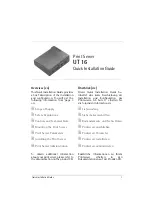
Local> DEFINE PORT n AUTOBAUD DISABLE SPEED speed
Local> DEFINE PORT n ACCESS REMOTE
Local> DEFINE PORT n TELNET server NEW LINE TO TERMINAL <CR>
Local> DEFINE PORT n TELNET server {ip}{ayt}{eor}{ao}{nop}NONE*
Local> INIT DELAY 0
Figure 5-4. Remote Site Telnet Setup.
*Each in a separate command line.
In this last scenario, a user might wish to connect a card-reader with
its centralized controller. Rather than using traditional modems, one will
transport the asynchronous data between the units using TCP/IP over a
WAN using the Terminal Server. A back-to-back connection would establish
a permanent virtual circuit so that any asynchronous data from the one unit
will be encapsulated in a TCP/IP packet and delivered to the other. In this
example, a session is opened between the card-reader and its controller and
any keystroke or data entered into the card-reader is transmitted to its
controller over TCP/IP.
Example 4: Remote Access with PPP and Windows 95
In this scenario, a user wishes to use a PC running Windows 95 to establish a
dedicated PPP link via a modem. In earlier versions of Windows, the dialup
was achieved by using third party Winsock applications (such as Trumpet)
and a script. In Windows 95, the TCP/IP stack is internal.
This operating system supports PPP through its dialup networking
configuration, with a default PAP authentication scheme. Although Windows
95 includes support for dialup networking, allowing computers to connect to
remote hosts, there is no provision for scripting.
To add scripting capabilities to Windows 95 dialup networking form the
CD version of Windows 95, use the included DScript utility. To install DScript,
use the double-click on Add/Remove Programs in Control Panel, click the
Windows Setup tab, click Have Disk button, and install from the
ADMIN\APPTOOLS\DSCRIPT directory on the CD.
98
TERMINAL SERVERS
Содержание LE2101A-BT-R2
Страница 2: ......
















































